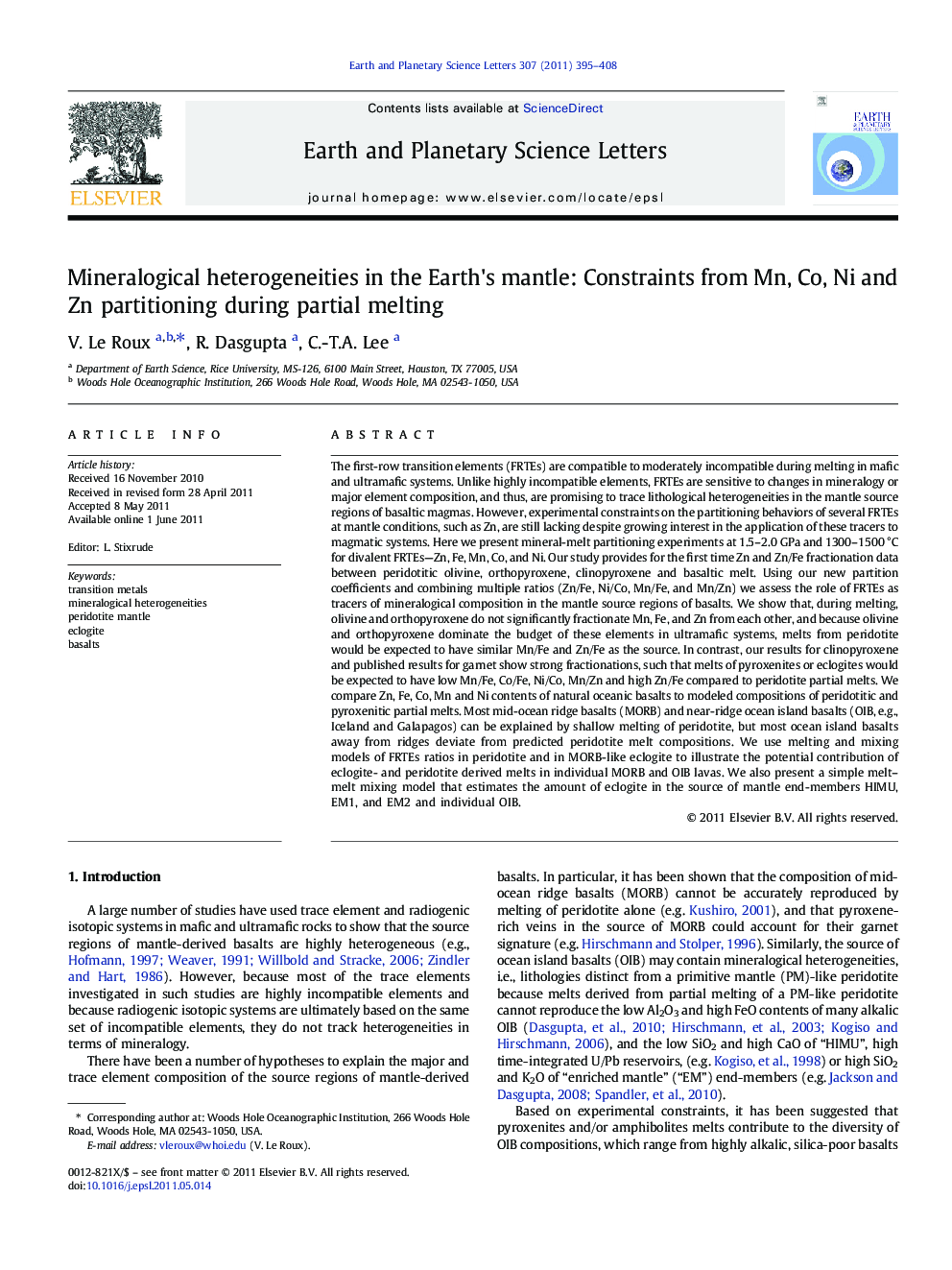| کد مقاله | کد نشریه | سال انتشار | مقاله انگلیسی | نسخه تمام متن |
|---|---|---|---|---|
| 4677910 | 1634825 | 2011 | 14 صفحه PDF | دانلود رایگان |

The first-row transition elements (FRTEs) are compatible to moderately incompatible during melting in mafic and ultramafic systems. Unlike highly incompatible elements, FRTEs are sensitive to changes in mineralogy or major element composition, and thus, are promising to trace lithological heterogeneities in the mantle source regions of basaltic magmas. However, experimental constraints on the partitioning behaviors of several FRTEs at mantle conditions, such as Zn, are still lacking despite growing interest in the application of these tracers to magmatic systems. Here we present mineral-melt partitioning experiments at 1.5–2.0 GPa and 1300–1500 °C for divalent FRTEs—Zn, Fe, Mn, Co, and Ni. Our study provides for the first time Zn and Zn/Fe fractionation data between peridotitic olivine, orthopyroxene, clinopyroxene and basaltic melt. Using our new partition coefficients and combining multiple ratios (Zn/Fe, Ni/Co, Mn/Fe, and Mn/Zn) we assess the role of FRTEs as tracers of mineralogical composition in the mantle source regions of basalts. We show that, during melting, olivine and orthopyroxene do not significantly fractionate Mn, Fe, and Zn from each other, and because olivine and orthopyroxene dominate the budget of these elements in ultramafic systems, melts from peridotite would be expected to have similar Mn/Fe and Zn/Fe as the source. In contrast, our results for clinopyroxene and published results for garnet show strong fractionations, such that melts of pyroxenites or eclogites would be expected to have low Mn/Fe, Co/Fe, Ni/Co, Mn/Zn and high Zn/Fe compared to peridotite partial melts. We compare Zn, Fe, Co, Mn and Ni contents of natural oceanic basalts to modeled compositions of peridotitic and pyroxenitic partial melts. Most mid-ocean ridge basalts (MORB) and near-ridge ocean island basalts (OIB, e.g., Iceland and Galapagos) can be explained by shallow melting of peridotite, but most ocean island basalts away from ridges deviate from predicted peridotite melt compositions. We use melting and mixing models of FRTEs ratios in peridotite and in MORB-like eclogite to illustrate the potential contribution of eclogite- and peridotite derived melts in individual MORB and OIB lavas. We also present a simple melt–melt mixing model that estimates the amount of eclogite in the source of mantle end-members HIMU, EM1, and EM2 and individual OIB.
Research highlights
► Transition elements ratios in basalts (e.g. Mn/Fe, Zn/Fe) can trace Cpx-Gt rich sources in the mantle.
► We performed partitioning experiments of Mn, Fe, Co, Ni and Zn between peridotite and basalt at 1.5–2 GPa, 1300–1500 °C.
► It is the first study of Zn partitioning at upper mantle conditions.
► We propose a simple melting and mixing model that quantifies Cpx-Gt rich heterogeneities in the mantle.
Journal: Earth and Planetary Science Letters - Volume 307, Issues 3–4, 15 July 2011, Pages 395–408